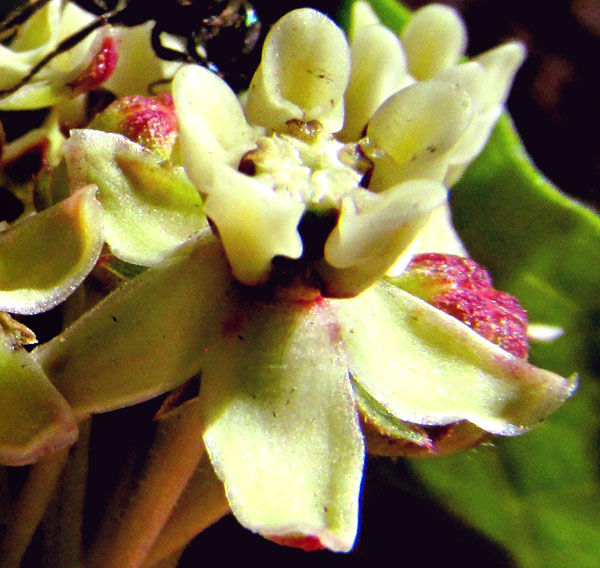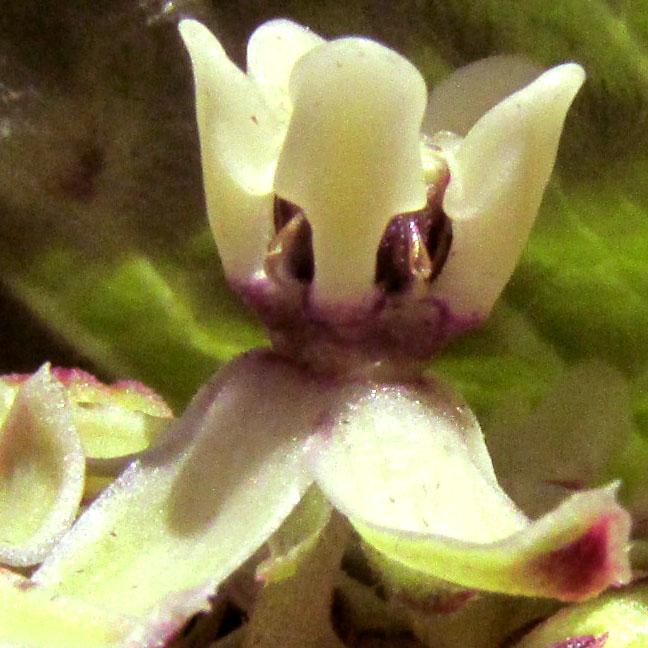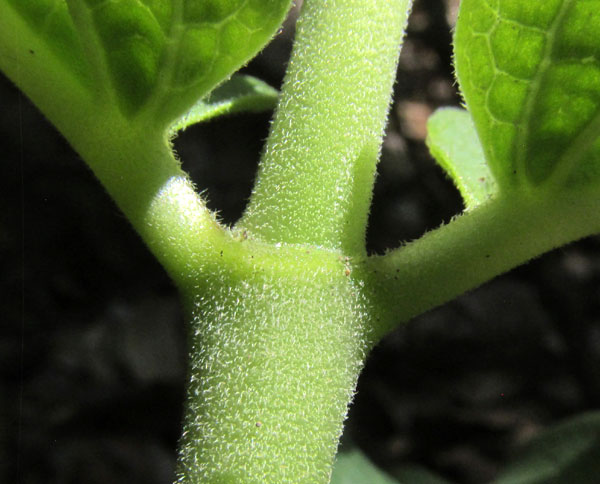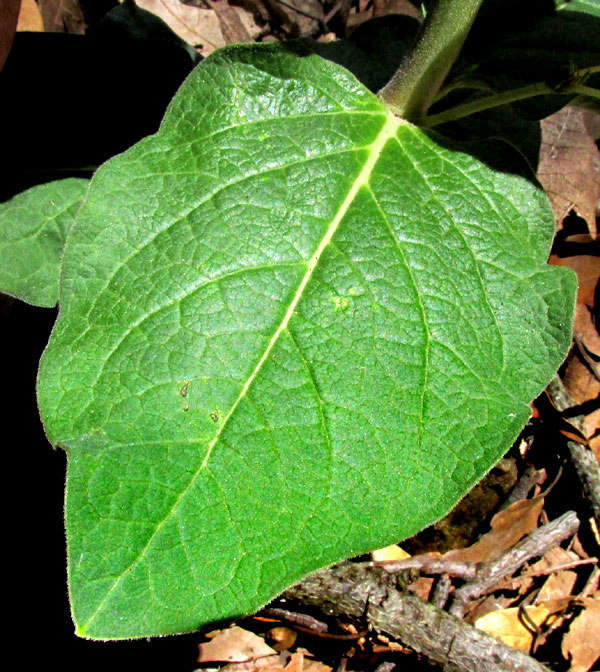Excerpts from Jim Conrad's
Naturalist Newsletter
entry from field notes dated July 2, 2022, taken on Cerro de la Cruz, at an elevation of ~2885m (~9465 ft), just south of the community of El Pinar, Amealco de Bonfil, Querétaro, MÉXICO, (~N20.17°, ~W100.17°)
"PRINGLE'S MILKWEED"

At the mouth of a valley opening toward the east and mantled with oak forest, the above milkweed was flowering. Anyone in the Americas or Europe familiar with the main groups of wildflowers will know it's a milkweed because of the peculiar shape of its flowers, evident even at the above distance, the flowers' particular manner of clustering together atop a long, stem-like peduncle, having leaves arise opposite one another on the stem, and the general fleshy appearance of the leaves. Confirming that it's a milkweed, a small tear in a leaf "bleeds" white, milklike latex.

Milkweeds are species of the genus Asclepias, of which over 200 species are recognized worldwide, with about 68 documented for Mexico. The Flora del Bajío normally used to identify plants in our dry, upland, central Mexican region doesn't consider the milkweeds, so I expected problems identifying this one, and paid close attention to its details. For example, the above picture shows this species' exceptionally long peduncles beneath the flower clusters, and the approximate number of flowers in each cluster. Below you see details of a flower:

Milkweed flower anatomy is unique and highly adapted for a particular kind of pollination. The most distinctive feature of a milkweed flower is that its male and female parts are fused into a structure referred to as the gynostegium. In the above picture, the gynostegium occupies the center of the circle of objects looking like tiptoeing slippers. In special milkweed terminology, the slippers are called corona limbs, or hoods. The flower's five petals spread from the base of the hoods, and shorter, green sepals peep from beneath the petals.
In the above picture, notice that on the far side of the gynostegium, three small, glistening, brown objects are visible, each opposite a hood. However, the nearest hoods aren't accompanied by brown things. Each brown thing, called a corpusculum, is part of an upside-down-V-shaped item called a pollinarium. Each pollinarium carries two tiny, waxy things called pollinia, which consist of stuck-together pollen grains. Therefore, in the above picture, one or more pollinators have removed the corpuscula with their pollinaria from beside the two nearest hoods, but three remain on the far side of the gynostegium. Theoretically, the pollinator will carry the pollinaria to the gynostegium of another flower, at which point male sex germs will have been delivered to a receptive female stigmatic disc, part of the gynostegium.

In the above picture, imagine a pollinator landing on the flower, and a pair of hoods directing one of the insect's groping legs into the narrow space between them. The leg, if positioned just right, is further directed into the slit just barely visible at the bottom of the upside-down-heart-shaped thing on the outer rim of the purple, nose-like protuberance extending outward between the hood bases. The leg gets stuck inside the slit, sometimes stuck so securely that the whole leg breaks off. When the insect jerks the leg upward, an upside-down-V-shaped pollinarium gets snagged on the leg, and the pollinarium's voyage begins to another flower's gynostegium.

In the above picture, four or five yellow pollinia are stuck to the insect's body. Each antenna bears either one or two, another pollinia adheres about midway up the tibia of the front leg on the left side of the insect, and maybe there's another on the front leg on the right. This shows that pollinia attach to more objects than legs. You can poke a needle into one of the flower's slits, lift it up, and often find an upside-down-V-shaped pollinarium stuck to it, with two yellow pollinia, as shown about halfway down our Milkweed Flowers page.
Here's what a leaf attachment point, or node, on the stem looks like:

And a leaf's general shape:

Fortunately for us, in 2018, Christopher Ostwaldo Cervantes Meza at the Universidad Autónoma del Estado de Hidalgo made available online his thesis entitled "Sinopsis del Género Asclepias Asclepiadoideae, Apocynaceae) de Hidalgo, México" -- a review of milkweeds in Hidalgo state, the border of which lies just a few kilometers east of where our plant grew. In that treatment, our plant "keys out" to, and fits the description and matches the pictures of, ASCLEPIAS PRINGLEI.
Asclepias pringlei bears no English name, but with that binomial it begs to be called "Pringle's Milkweed," which I do, the quotation marks indicating that nobody else uses it. The species is endemic just to Mexico, from Baja California and Veracruz south to Oaxaca, mostly appearing in oak-pine forests at elevations between 1530-3100 meters (5000-10,200 ft).
The main features making this a "Pringle's Milkweed" include the flowers' white color, the flower clusters' long peduncles, the leaves' short petioles, their broad blades which are somewhat squared at the base, and the relative heights/lengths of the hoods, gynostegium, and petals. However, the most definitive feature is something not there.
On our Milkweed Flowers page, second picture down, you'll notice slender, conical structures identified as horns. In the vast majority of milkweed flowers the horns are very conspicuous. Our flowers don't have them, or maybe only very short ones. Above, in our first picture of a single flower -- third picture from the top -- none of the hoods have horns arising at the bottoms of their openings, except the very short one on the picture's left side.
Returning to the pollinator in our picture, I'm unsure whether it's a bee or a wasp. It has a very narrow waist between the thorax and abdomen, its legs are roundish in cross-section, not flatish, and its mouthparts are sharply pincerlike, all like a wasp, not a bee. However, it's somewhat hairy like a bee, and in general wasps aren't thought of as pollinators. Maybe the insect has pollinaria stuck in the wrong places because she's a wasp, not a bee.
Finally, our plant was named in honor of Cyrus Pringle, a US botanist who lived from 1838 to 1911, and was the first to bring to the attention of science many plant species from the arid US Southwest and northwestern Mexico. We've run into Pringle plants many times here. He was a Quaker who refused to fight in the Civil War, even when tortured by the Army and threatened with death. You can read more about this fine man on Wikipedia's Cyrus Pringle page.